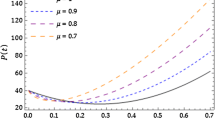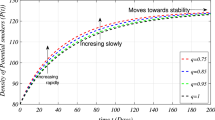Abstract
In this paper, an epidemic model is presented to describe the dynamics of drugs usage among the adults. The Caputo fractional derivative operator of order \(\phi \in (0, 1]\) is employed to obtain the system of fractional differential equations. Smoking is the large problem in the entire world. Despite the overwhelming facts about smoking, it is still a bad habit which is widely spread and socially accepted. A non-linear mathematical model is established to study and assess the dynamics of smoking and its impact on public health in a community. The analysis of two different states, disease free and endemic which means the disease dies out or persist in a population has been made by presenting sensitivity analysis. The stability of the model is provided by threshold or reproductive number. The Laplace Adomian decomposition method has been employed to solve smoking model which has five compartments, potential smoker P, occasional smokers O, smokers S, temporarily quit smokers Q and permanently quit smokers L. Finally, some numerical results are presented which shows the effect of fractional parameter \(\phi \) on our obtained solutions.





Similar content being viewed by others
References
Biazar, J.: Solution of the epidemic model by Adomian decomposition method. Appl. Math. Comput. 173, 1101–1106 (2006)
Busenberg, S., Driessche, P.: Analysis of a disease transmission model in a population with varying size. J. Math. Bio. 28(1990), 65–82 (1990)
El-Sayed, A.M.A., Rida, S.Z., Arafa, A.A.M.: On the solutions of time-fractional bacterial chemotaxis in a diffusion gradient chamber. Int. J. Nonlinear Sci. 7, 485–495 (2009)
Makinde, O.D.: Adomian decomposition approach to a SIR epidemic model with constant vaccination strategy. Appl. Math. Comput. 184, 842–848 (2007)
Arafa, A.A.M., Rida, S.Z., Khalil, M.: Fractional modeling dynamics of HIV and 4 T-cells during primary infection. Nonlinear Biomed. Phys. 6, 1–7 (2012)
Kribs-Zaleta, C.M.: Structured models for heterosexual disease transmission. Math. Biosci. 160, 83–108 (1999)
Buonomo, B., Lacitignola, D.: On the dynamics of an SEIR epidemic model with a convex incidence rate. Ricerche Mat. 57, 261–281 (2008)
Liu, X., Wang, C.: Bifurcation of a predator–prey model with disease in the prey. Nonlinear Dyn. 62, 841–850 (2010)
Haq, F., Shah, K., Rahman, G., Shahzad, M.: Numerical solution of fractional order smoking model via Laplace Adomian decomposition method. Alex. Eng. J. (2017). https://doi.org/10.1016/j.aej.2017.02.015
Erturk, V.S., Zaman, G., Momani, S.: A numeric analytic method for approximating a giving up smoking model containing fractional derivatives. Comput. Math. Appl. 64, 3068–3074 (2012)
Zaman, G.: Optimal campaign in the smoking dynamics. Comput. Math. Methods Med. Article ID 163834 (2011)
Zaman, G.: Qualitative behavior of giving up smoking models. Bull. Malays. Math. Soc. 34, 403–415 (2011)
Lubin, J.L., Caporaso, Z.E.: Cigarette smoking and lung cancer: modeling total exposure and intensity. Cancer Epidemiol. Biomark. Prev. 15, 517–523 (2006)
Garsow, C.C., Salivia, G.J., Herrera, A.R.: Mathematical Models for the Dynamics of Tobacoo Use, Recovery and Relapse. Technical Report Series BU-1505-M, Cornell University, UK (2000)
Sharomi, O., Gumel, A.B.: Curtailing smoking dynamics: a mathematical modeling approach. Appl. Math. Comput. 195, 475–499 (2008)
Zeb, A., Chohan, I., Zaman, G.: The homotopy analysis method for approximating of giving up smoking model in fractional order. Appl. Math. 3, 914–919 (2012)
Alkhudhari, Z, Al-Sheikh, S, Al-Tuwairqi, S: Global dynamics of a mathematical model on smoking. Appl. Math. Article ID 847075 (2014)
Khalid, M., Khan, F.S., Iqbal, A.: Perturbation-iteration algorithm to solve fractional giving up smoking mathematical model. Int. J. Comput. Appl. 142, 1–6 (2016)
Agila, A., Baleanu, D., Eid, R., Irfanoglu, B.: Applications of the extended fractional Euler–Lagrange equations model to freely oscillating dynamical systems. Romanian J. Phys. 61, 350–359 (2016)
Abelman, S., Selvakumaran, K.A., Rashidi, M.M., Purohit, S.D.: Subordination conditions for a class of non-Bazilevivc type defined by using fractional q-calculus operators. Facta Universitatis Ser.: Math Info. 32, 255–267 (2017)
Singh, J., Rashidi, M.M., Kumar, D., Swroop, R.: A fractional model of a dynamical Brusselator reaction–diffusion system arising in triple collision and enzymatic reactions. Nonlinear Eng. 5, 277–285 (2016)
Kumar, S., Kumar, D., Abbasbandy, S., Rashidi, M.M.: Analytical solution of fractional Navier–Stokes equation by using modified Laplace decomposition method. Ain Shams Eng. J. 5, 569–574 (2014)
Yang, A., Zhang, Y.Z., Cattani, C., Xie, G., Rashidi, M.M., Zhou, Y.J., Yang, X.J.: Application of local fractional series expansion method to solve Klein–Gordon equations on cantor sets, Abst. Appl. Anal. Article ID 372741 (2014)
Kilbas, A.A., Srivastava, H.M., Trujillo, J.J.: Theory and Applications of Fractional Differential Equations. Elsevier, Amsterdam (2006)
Bulut, H, Baskonus, H.M., Belgacem, F.B.M.: The analytical solutions of some fractional ordinary differential equations by Sumudu transform method. Abstr. Appl. Anal. Article ID 203875 (2013)
Singh, J., Kumar, D., Qurashi, M., Baleanu, D.: A new fractional model for giving up smoking dynamics. Adv. Differ. Equ. (2017). https://doi.org/10.1186/s13662-017-1139-9
Area, I., Batarfi, H., Losada, J., Nieto, J.J., Shamma, W., Torres, A.: On a fractional order Ebola epidemic model. Adv. Differ. Equ. (2015). https://doi.org/10.1186/s13662-015-0613-5
Atangana, A., Nieto, J.J.: Numerical solution for the model of RLC circuit via the fractional derivative without singular kernel. Adv. Mech. Eng. 7, 1–7 (2015)
Shahed, M.E., Nieto, J.J., Ahmed, J.J., Abdelstar, I.: Fractional-order model for biocontrol of the lesser date moth in palm trees and its discretization. Adv. Differ. Equ. (2017). https://doi.org/10.1186/s13662-017-1349-1
Jafari, H., Khalique, C.M., Nazari, M.: Application of the Laplace decomposition method for solving linear and nonlinear fractional diffusion-wave equations. Appl. Math. Lett. 24, 1799–1805 (2011)
Jafari, H., Khalique, C.M., Khan, C.M., Ghasemi, M.: A two-step Laplace decomposition method for solving nonlinear partial differential equations. Int. J. Phys. Sci. 6, 4102–4109 (2011)
Johnston, S.J., Jafari, H., Moshokoa, H., Ariyan, H., Baleanu, D.: Laplace homotopy perturbation method for Burgers equation with space and time-fractional order. Open Phys. 14, 247–252 (2016)
Ullah, R., Khan, M., Zaman, G.: Dynamical features of a mathematical model on smoking. J. Appl. Environ. Biol. Sci. 6, 92–96 (2016)
Hassan, H.N., El-Tawil, H.N.: A new technique of using homotopy analysis method for solving high-order nonlinear differential equations. Math. Methods Appl. Sci. 34, 728–742 (2011)
Liao, S.J.: A kind of approximate solution technique which does not depend upon small parameters: a special example. Int. J. Non-Linear Mech. 30, 371–380 (1995)
Magin, R.: Fractional Calculus in Bioengineering. Begell House Publishers, Danbury (2004)
Author information
Authors and Affiliations
Corresponding author
Rights and permissions
About this article
Cite this article
Abdullah, M., Ahmad, A., Raza, N. et al. Approximate Solution and Analysis of Smoking Epidemic Model with Caputo Fractional Derivatives. Int. J. Appl. Comput. Math 4, 112 (2018). https://doi.org/10.1007/s40819-018-0543-5
Published:
DOI: https://doi.org/10.1007/s40819-018-0543-5




